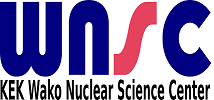Study of nuclear structure of the nuclei around A=195
Only beta-decay half-lives and masses of neutron-rich nuclei around A=195 enable to deduce the correlation between the temperature and the neutron density of astrophysical environment for synthesizing the heavier elements than iron. However, it has been difficult to produce these heavy nuclei by using the usual nuclear reaction so far. Therefore, the astrophysical environment has not been revealed experimentally. We plan to reveal the astrophysical environment from the nuclear spectroscopy of the heavy nuclei produced and separated by using multi-nucleon transfer reaction and element selective isotope separation system (KEK isotope separation system:KISS), respectively.
- beta-decay spectroscopy (half-lives measurement)
- atomic mass measurement
- gamma-ray spectroscopy
- laser ionization spectroscopy
Please visit our KISS web page for more details.
Heavy ion nuclear reaction with ~10 MeV/nucleon (multi-nucleon transfer reaction)
From the systematic measurement of production cross-section of multi-nucleon transfer (MNT) reaction products at GANIL, we concluded that the MNT reaction is suitable for the production of neutron-rich nuclei around A=195 or the mass region of 238U. However, there is no theoretical models which can predict the production cross-section quantitatively. Therefore, we have started the research of the heavy ion reaction mechanism in order to understand the mechanism and improve the prediction accuracy of the production cross-section.
Please visit our KISS web page for more details.
Precision mass measurements of nuclei near the N=Z line
We’re going to perform the precision mass measurements for revealing to rapid proton-capture process drives the explosive astronomical phenomenon-called type I X-ray burst. We successfully performed the mass measurements of proton-rich nuclei with precision of the order of 10-7 to 10-8 by using the multi-reflection time-of-flight mass spectrograph MRTOF.
Direct mass measurements for nuclei in the very heavy element region by means of MRTOF
The MRTOF provides an efficient means to perform mass measurements of multiple ions species simultaneously. This allows us to gain knowledge about e.g. nuclear structure and also to unambiguously identify nuclei produced online.
You can find the details in the page of MRTOF.
Direct measurement of diffusion constant of the materials in lithium-ion battery
Mobility (diffusion constant) of lithium ions in the conductors of the lithium-ion battery, and properties of the electrode materials govern the electromotive force and lifetime of the battery. However, it is impossible to measure the mobility directly by applying the traditional methods such as neutron scattering and resistance measurements. Therefore, we developed new non-destructive direct method. The following is the content of the method. We implant the low-energy short-lived 8Li ion beam with the energy of a few keV into the battery material with our interest whose thickness is a few hundred nm. Then, we measured the time-response of the number of alpha-particles emitted after the 8Li beta-decay. Finally, we successfully evaluate the diffusion constant by using newly-developed non-destructive direct method. In order to improve the performance of the battery, we search for new electrode materials and conductors by applying the new method.

